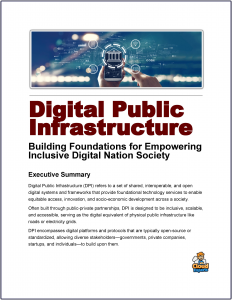India’s Digital Public Infrastructure: A Global Revolution in Technology
India's pioneering advancements in DPI are transforming its economy and also shaping a global blueprint that other countries can follow.
 India has emerged as a global leader in Digital Public Infrastructure (DPI), often called the “India Stack,” a suite of interoperable digital systems driving inclusion and innovation.
India has emerged as a global leader in Digital Public Infrastructure (DPI), often called the “India Stack,” a suite of interoperable digital systems driving inclusion and innovation.
Central to this is Aadhaar, a biometric-based digital identity system enrolling over 1.3 billion people, enabling seamless access to banking, government subsidies, and healthcare.
It has integrated millions, especially in rural areas, into the formal economy by simplifying identity verification.
Complementing Aadhaar, the Unified Payments Interface (UPI) powers instant, low-cost money transfers, handling over half of global financial transactions by volume. From small vendors using QR codes to individuals making peer-to-peer payments via apps like PhonePe, UPI has transformed India’s digital economy.
Data exchange platforms, like the Account Aggregator and Unified Health Interface, facilitate secure, consent-based sharing of financial and health data, empowering users while fostering interoperability. Built on open-source technologies, India’s DPI avoids proprietary lock-in, inspiring global frameworks like MOSIP.
Despite challenges like privacy concerns with Aadhaar and ensuring accessibility for non-tech-savvy users, India addresses these through encryption, consent protocols, and offline solutions. By enabling rapid crisis responses, such as cash transfers during COVID-19, and influencing countries like the Philippines, India’s DPI model sets a global standard for inclusive digital transformation.
Gates Foundation
The Gates Foundation are playing a central role in sharing DPI best practices and growing adoption across the world.
Led by Sanjay Jain and Daniel Radcliffe it has committed $200 million over five years to advance DPI, focusing on open-source tools like MOSIP for digital ID and Mojaloop for payments, enabling countries to build affordable, tailored systems. The program emphasizes inclusive design to address privacy, accessibility, and gender equity, ensuring benefits reach marginalized groups.
By collaborating with governments, private sectors, and organizations like the UN and World Bank, the Foundation supports DPI adoption in over 20 countries, including Ethiopia and the Philippines, to accelerate progress on global development goals, reduce poverty, and empower communities through secure, interoperable digital systems.
In his article, Bill Gates discusses the transformative potential of digital public infrastructure (DPI), which he likens to physical infrastructure like roads and bridges, but for the digital world.
Gates highlights DPI’s impact in areas like banking, health, agriculture, and crisis response, citing examples such as India’s Aadhaar system, which has integrated millions into the formal economy, and Togo’s rapid cash transfer program during COVID-19. He emphasizes that well-designed DPI fosters inclusion, innovation, and competition by leveraging open-source tools like MOSIP for digital identity and Mojaloop for payments. These tools allow countries to build customized, cost-effective systems without relying on proprietary solutions.
The Gates Foundation has committed $200 million over five years to support DPI initiatives, aiming to advance global development goals, particularly in low- and middle-income countries. Gates also addresses concerns about DPI, such as privacy and accessibility, noting that proper design can mitigate risks and ensure inclusivity for vulnerable populations.
He cites Estonia’s X-Road platform, where 99% of public services are online, as a model for efficient digital governance. Overall, DPI is presented as a critical tool for accelerating progress, reducing poverty, and empowering communities, with the potential to leapfrog traditional development pathways.




